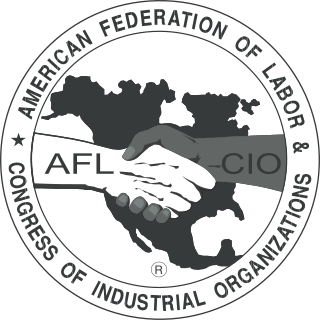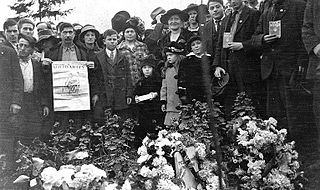
The American Federation of Labor and Congress of Industrial Organizations (AFL–CIO) is the largest federation of unions in the United States. It is made up of 60 national and international unions, together representing more than 12 million active and retired workers. The AFL–CIO engages in substantial political spending and activism, typically in support of progressive and pro-labor policies.

The Freedom Socialist Party is a left-wing socialist political party with a revolutionary feminist philosophy based in the United States. It views the struggles of women and minorities as part of the struggle of the working class. It emerged from a split in the United States Socialist Workers Party in 1966. The party's Seattle branch, with support from individuals in other cities, split off from the SWP over what it described as the SWP's entrenched opportunism and undemocratic methods. The party has branches and members in the United States, as well as Australia, England, Germany and New Zealand. The current National Secretary of the FSP is Doug Barnes.

The Seattle General Strike was a five-day general work stoppage by 65,000 workers in the city of Seattle, Washington from February 6 to 11, 1919. The goal was to support shipyard workers in several unions who were locked out of their jobs when they tried to strike for higher wages. Most other local unions joined the walk-out, including members of the American Federation of Labor (AFL) and the Industrial Workers of the World (IWW). The national offices of the AFL unions were opposed to the shutdown. Local, state and federal government officials, the press, and much of the public viewed the strike as a radical attempt to subvert American institutions.
Radical Women (RW) is a socialist feminist grassroots activist organization affiliated with the Freedom Socialist Party. It has branches in Seattle, Washington, and Melbourne, Australia.

The Bracero Programs were the result of a series of laws and diplomatic agreements, initiated on August 4, 1942, when the United States signed the Mexican Farm Labor Agreement with Mexico. For these farmworkers, the agreement guaranteed decent living conditions and a minimum wage of 30 cents an hour, as well as protections from forced military service, and guaranteed that a part of wages was to be put into a private savings account in Mexico; it also allowed the importation of contract laborers from Guam as a temporary measure during the early phases of World War II.

The Everett massacre, also known as Bloody Sunday, was an armed confrontation between local authorities and members of the Industrial Workers of the World (IWW) union, commonly called "Wobblies". It took place in Everett, Washington, on Sunday, November 5, 1916. The event marked a time of rising tensions in Pacific Northwest labor history.
The Bellingham riots occurred on September 4, 1907, in Bellingham, Washington, United States. A mob of 400–500 white men, predominantly members of the Asiatic Exclusion League, with intentions to exclude Indian immigrants from the work force of the local lumber mills, attacked the homes of the South Asian Indians. The Indians were mostly Sikhs but were labelled as Hindus by much of the media of the day.
Seattle City Light is the public utility providing electricity to Seattle, Washington, in the United States, and parts of its metropolitan area, including all of Shoreline, nearly all of Lake Forest Park, and parts of unincorporated King County, Burien, Normandy Park, SeaTac, Renton, and Tukwila. Seattle City Light is the 10th largest public utility in the United States and the first municipal utility in the US to own and operate a hydroelectric facility. In 2005, it became the first electric utility in the United States to fully offset all its carbon emissions and has remained carbon neutral every year since.
The Seattle Civil Rights and Labor History Project, one of the Pacific Northwest Labor and Civil Rights History Projects, is dedicated to social movements and labor history in the Pacific Northwest. It is directed by Professor James N. Gregory of the University of Washington. The project represents a unique collaboration between community organizations and University faculty, as well as undergraduate and graduate students. It has become a model of public history across the US and has been credited with changing the discussion of race and civil rights in the Seattle area.
The La Guardia and Wagner Archives was established in 1982 at LaGuardia Community College in Long Island City, Queens, New York, to collect, preserve, and make available primary materials documenting the social and political history of New York City, with an emphasis on the mayoralty and the borough of Queens. The purpose of its founding went beyond serving as a repository, but to establish the college as a location for scholarly research. The archives serves a broad array of researchers, journalists, students, scholars, exhibit planners, and policy makers. Its web site provides guidelines to the collections, as well as over 55,000 digitized photographs and close to 2,000,000 digitized documents.
The Martin Luther King, Jr. County Labor Council (MLKCLC) is the central body of labor organizations in King County, Washington. The MLKCLC is affiliated with the national AFL–CIO, the central labor organization in the United States, which represents more than 13 million working people. Over 125 organizations are affiliated with the MLKCLC, and more than 75,000 working men and women belong to Council-affiliated organizations. Not only does the MLKCLC support labor organizations, but it acts as a voice for the interests and needs of the working people in King County, WA.
The Waterfront Workers History Project is a program of the University of Washington, which serves to document the history of workers and unions active on the ports, inland waterways, fisheries, canneries, and other waterfront industries of the western United States and Canada, specifically, California, Oregon, Washington, Alaska, and British Columbia. In collaboration with the Pacific Northwest Labor and Civil Rights History Projects, and sponsored by the Harry Bridges Center for Labor Studies, the Project is a collective effort to organize and present historical data covering significant events from 1894 to the current day.
The Great Depression in Washington State Project is a multimedia web resource based at the University of Washington in Seattle. Created in the context of renewed economic hard times in 2009, the Project includes essays, maps, digitized newspaper articles and hundreds of rare photographs from the 1930s. In addition to rapid industrialization and demographic change, the Depression ended decades of Republican rule, created a powerful labor movement, changed the face of the Democratic Party and molded new set of political priorities. In several thematic sections, the Project examines these changes in everyday life, culture, politics and work. The Project is one of the Pacific Northwest Labor and Civil Rights History Projects, characterized by student-led research and public scholarship.
The Labor Press Project: Pacific Northwest Labor and Radical Newspapers is a multimedia website housing thousands of digitized articles and editions from the late 19th century to the present. Newspapers and newsletters from unions, early socialist groupings, anarchist communes, ethnic community groups and radical organization are presented on the site with accompanying research articles on their context and evolution. Many of the digitized materials were previously unavailable except as archival material. The extensive resource is one of Pacific Northwest Labor and Civil Rights History Projects developed by the University of Washington.
The Black Panther Party History and Memory Project is a multimedia effort to chronicle the Seattle chapter of the Black Panther Party. Founded in 1968, the Seattle Chapter was one of the first to be formed outside Oakland and became one of longest lived bases of the Party. The Project is the largest online collection of materials about any branch of the organization. The materials include detailed video oral histories, historical documents and photographs and the complete transcript of a 1970 Congressional Hearing held on the Seattle Chapter. The Project is an initiative of the Seattle Civil Rights and Labor History Project at the University of Washington.
The Pacific Northwest Labor and Civil Rights History Projects are a series of multimedia public history initiatives. The projects cover a range of themes and subjects in the Northwest and Seattle, with a particular focus on working people and their movements. The effort, particularly the Seattle Civil Rights and Labor History Project, has garnered praise for the breadth of primary and secondary resources made available and its joint creation by academics, community members and hundreds of students. It has been recognized as a model of digital and publicly engaged scholarship.
Strikes! Labor History Encyclopedia of the Pacific Northwest is a clearinghouse of information on the labor history of the region developed by the University of Washington and Professor James N. Gregory as part of the Pacific Northwest Labor and Civil Rights History Projects. The Encyclopedia covers the major industries of Washington state, major unions and worker struggles, civil rights activism among many ethnic communities, radical organizations, the Great Depression and the New Deal and the region's rich history of labor and radical newspapers.
Revels Cayton (1907–1995) was an American civil rights leader active in the states of Washington and California.
In June of 1867, two thousand Chinese Transcontinental Railroad workers participated in a general strike for a week along the Sierra Nevada range, demanding better working conditions. By 1867, the Central Pacific Railroad workforce was composed of 80-90% Chinese laborers and the rest were European-Americans. The workers in the Chinese project were literate and well organized, but left no written records. Despite the lack of written account from the Chinese workers, it is apparent from reports in the press and from the railroad bosses that the Chinese workers were hard-working, peaceful, and that the strike was carried out with no violence. The strike was organized in June, at the time of the Summer Solstice, and carried it out a way that strongly reflected Confucian values. The strike lasted a little over a week, and the workers returned peacefully to work.

Hildreth (Heidi) Durham was an American socialist feminist and labor activist with the Freedom Socialist Party and Radical Women. Durham was one of the first female electricians to work at Seattle City Light, where she faced significant barriers due to pervasive sexism and suffered a nearly fatal accident that left her paralyzed for the rest of her life. In 1991, Durham was a candidate in the Seattle City Council elections on the Freedom Socialist Party ticket with Yolanda Alaniz.





